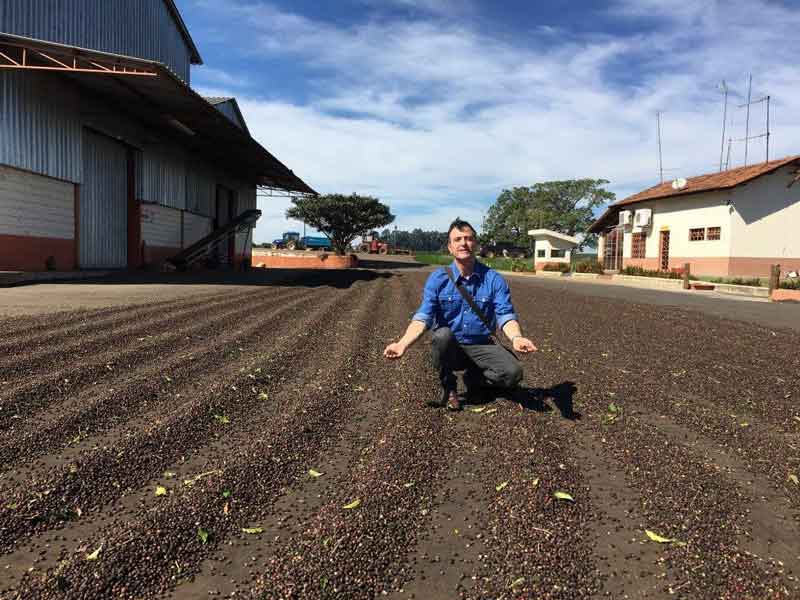5 Days as a Green Bean Buyer in Brazil

Going to the origin is one of the most unique experiences for any coffee lover. Besides finding hidden gems and unique flavours, it is rewarding to exchange knowledge and learn from the ones responsible for growing and processing the coffee we drink in Australia. Our relationship with the farmers gets stronger every time we visit them. And we develop great appreciation for the awesome work they do. That is one of the reasons why we visit Brazil every year.
So, today let us share with you what it is like to be traveling from farm to farm in Brazil.
Day 1 – Getting there!
Travelling from Australia to Brasil means to be at least 24 hours en route. As there is no direct flight, our itinerary involved a stop in NZ and another stop in Chile. We finally landed in Sao Paulo, Brazil’s largest city (around 12 million people!) where we could rest for one night.
Day 2 – Fazenda Bom Jesus & GIMA
The first farm visited was Fazenda Bom Jesus, in the city of Franca, Alta Mogiana region, where our friends Flavia and Gabriel have been growing coffee for nearly 150 years. The area is impressive, approximately 8,000 hectares where they plant mainly Bourbon and Mundo Novo varieties.
But this year there was something even more special about our visit. For the first time we were able to be part of the opening ceremony of GIMA, the Intermunicipal Games for the Environment. For 10 years Bom Jesus farm has been organising this event to create environmental and social awareness on youngsters by performing sports, dance and cultural activities. There were more than 900 children from 4 different small cities there, on a special moment to share knowledge and entertainment. It was impressive to share moments with sons and daughters of coffee pickers, these people are surrounded by coffee since they’re born.
The highlight of the day was to deliver 20 bikes to children, all bought with money raised by our friends from Disciple Roasters and the earnings of their coffee shop last year on Christmas Day! Moments like these really make you feel emotional, it was a unique experience to be there knowing that each bag of Bom Jesus has an impact on the development of children in need. It was one of the moments where you believe a good action can definitely change the world.
Day 3 – On the way to Minas Gerais
The best way to move around the countryside of Brazil is by car. After having rented one, the next stop was Sao Goncalo do Sapucai, a small city with around 20 thousand inhabitants, located in Southern Minas Gerais. I was lucky to be part of the Rosario festivities, the most traditional party in the area, dated from 1880 and linked to the religious calendar (exactly 50 days after Easter).
Day 4 – Farmers from APAS
The day started early. At 7.30am, Ademilson Noiman picked me up for a breakfast with the members of APAS. Let me explain, APAS stands for the Association of Producers from Alto da Serra, founded in 1996 by a group of
small farmers, aiming to improve their production conditions and quality. From this union, and by being able to join local competitions, such as COE, they could discover how special and unique their coffees are.
The association is located in the south of Minas Gerais, in altitudes between 1,000m and 1,400m above sea level. Quality, traceability, good agricultural practices, social and environmental responsibility, and food safety are the main pillars of APAS. Therefore, their members are all certified byCertifica Minas Cafe and Fair Trade.
The most touching aspect of travelling to the origin to me is to see with my own eyes how we can change the lives of small producers by buying their amazing coffee and bringing it to Australia. These humble farmers are just so grateful for being able to send their coffee overseas, and knowing that people really appreciate the hard work they do the whole year just for those few micro-lot bags. Their testimonials made us speechless. As we always say, coffee is made of stories, and people.
Unfortunately we didn’t have time to visit all the farms, some of the farms we went were: Pinheirinho, Sao Jose, Bela Vista, Nossa Senhora & Aparecida. Even though they are in the same region they are a bit far from each other. It was time to leave to the last stop: Santo Antonio do Amparo.
Day 5 – Santo Antonio & Pinhal Farms
During the last day of the trip we visited Pedro and Newton’s farms. Pedro is the 5th generation of coffee growers in his family. Their farmhouse was built in 1824, nearly 200 years ago!
Santo Antonio operation is impressive and a great example of the unique opportunities afforded by the highly established Brazilian coffee industry. The group of farms, each of which are outstanding feats in and of themselves, have a centralised lab, warehouse and dry mill where a dedicated quality control team of Q Graders cups and manages quality for the collective. Working as a group via the lab enables these estates to share and gain from the collectives many years of combined experience.
Today, the farm operates in reforestation, but the coffee production is the main activity. They hold Rain Forest Alliance and UTZ Certifications and they are working on a project to protect injured birds in the region.
To finish the visit to Brazil, the most amazing sunrise I’ve seen.











